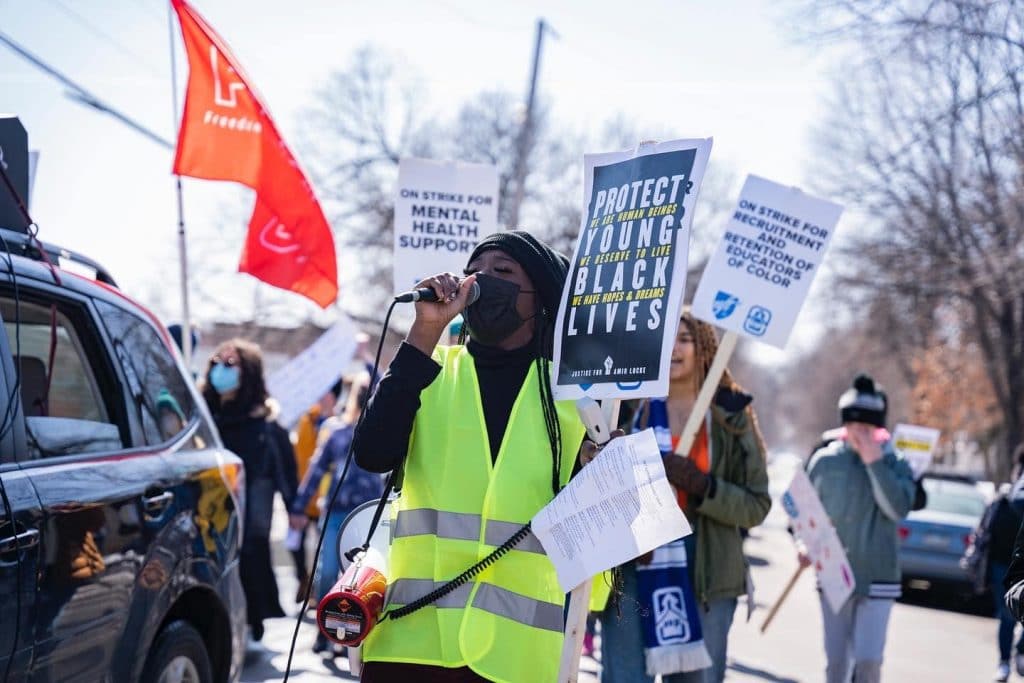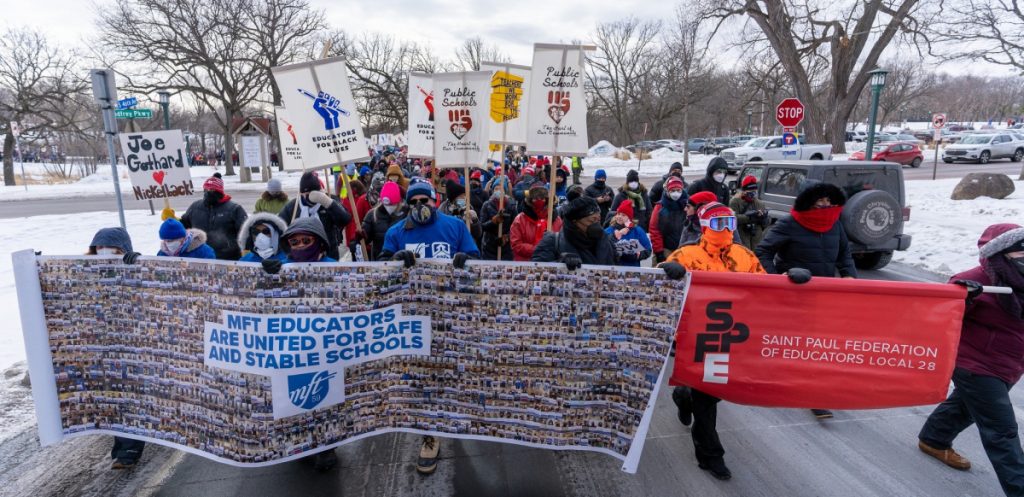“We Got Your Back”: Student Protest in Solidarity with Teachers Strike
Students organized a march and sit in in solidarity with Minneapolis educators.
Tatiana Cozzarelli March 16, 2022

We ain’t shy.
We ain’t timid.
We are angry.
We are livid.
—Student chant
Dozens of Minneapolis public school students organized a march and a sit-in to stand in solidarity with public school educators who entered their second week on strike.
The students gathered at North High School and many held homemade signs, as well as some of the union signs speaking about the need for smaller class sizes, hiring more BIPOC teachers, and more.
The action had been called the night before — a rally called at 5 p.m. for an action at 11:30 a.m. A student walkout in solidarity with teachers had been called and then canceled before the strike began. “We just had to do something for our teachers,” one student explained.
After a crowd of a few dozen gathered, they took to the streets, walking on the road, crossing puddles of melted snow, and chanting into megaphones as a sound car followed. The chants were reminiscent of the Black Lives Matter movement:
“You can’t stop the revolution!”
“Ain’t no power like the power of the people, cuz the power of the people don’t stop.”
“Black Lives, they matter here. Teachers, they matter here. Students, they matter here.”
“Whose schools? Our schools!”
Markeanna, a senior who helped organize the march, said, “We hear politicians talking about the strike and saying, ‘You’re harming the students!’ And we say, ‘Bullshit.’ We are behind our teachers! Teachers’ working conditions are student learning conditions!”
The students were marching toward the Davis Center, where negotiations have been stalled for weeks. Outside, over 50 teachers were picketing, with chants and even a marching band.
The students approached, chanting “We got your back.” The teachers — many of whom didn’t know the students were coming — exploded into applause and cheers. They stopped the picket lines, took out their phones, and recorded the students.
It was absolutely electric.
Many teachers began chanting, “These are our students!” It felt like an explosion of joy and pride. One teacher ran out of the crowd and took a picture with some of the students — those were her students!
The students then went forward into the Davis Center, entering the building and chanting in the halls with megaphones. The mood was defiant; we are here, we support our teachers, and we want the whole building to know.
The educator’s negotiation team came out of a conference room and joined the students in chants.
Afterward, students sat down and listened to multiple speeches. You can watch the entire livestream here.
The first speaker, Khadejah, explained that her school had experienced loss. Deshaun Hill, a 15-year-old student from North High School, was murdered by a 29-year-old-man in February. It was a deep loss for both teachers and students — and teachers act as both therapists, parents, and teachers.
“Teachers don’t ask for much. They do their job. They love their job, and in the end, if they are asking for something, why not give it to them? They are the ones who are educating the next generation.”
She went on to say, “When it comes to teachers, it’s like their pen is broke. … You want to invest in more police, but you don’t want to invest in teachers.”
All speakers expressed a deep admiration for teachers and Educational Support Professionals. “Teachers made me who I am today,” said Saturn, a middle school student.
After about an hour of speeches, the rally ended, music came on, and the kids started line dancing: the cupid shuffle, the wobble, and more. These powerful students laughed, joked, and acted like the kids that they are.
But don’t be mistaken. These kids aren’t like other generations. They were molded by the complete failure of the state in the pandemic and by police violence, the murder of George Floyd, and the subsequent uprising.
Emi, a senior and co-student council president, ended the rally saying, “It doesn’t end today. We’re gonna be back tomorrow. We’re gonna be back the next day. We’re gonna be back every single day. If an agreement is reached, we’re still gonna be out here because there is still change that needs to be made in the city and the students have to show up.
No Money for Educators, but Minnesota Funds the Police
On Tuesday, March 8, Minneapolis education workers went on strike for living wages, smaller class sizes, and hiring teachers of color. While they have been told consistently that there isn’t enough money to pay educational support workers higher wages, the police budget continues to balloon.
Daniel Alfonso and K.S. Mehta
March 13, 2022

On Tuesday, March 8, Minneapolis education workers, including teachers and education support professionals (ESP), went on strike for living wages, smaller class sizes, and hiring of BIPOC teachers. What does this have to do with the police? More than it would seem at first glance.
Minneapolis Mayor Jacob Frey and Superintendent Ed Graff have repeatedly cited lack of funds to deny the teachers’ union’s demands. The imperative to be “fiscally responsible” is always bourgeois politicians’ response whenever workers make demands on them.
Last December, Mayor Frey and the city council agreed to a $1.6 billion budget, of which a whopping $191 million will go to the police, restoring the department’s funding to nearly the level it was before George Floyd was killed in 2020.
The Black Lives Matter movement was reignited in Minneapolis after Derek Chauvin brutally killed George Floyd and spread throughout the country and abroad. “Justice for George Floyd” was one of the core demands of the movement, as well as for the state to “defund the police.” In Minneapolis, this movement was especially strong, with hundreds of thousands taking the street every day and even burning a police station. City officials paid lip service to “defunding” police budgets, and the Minneapolis City Council voted in December 2020 to transfer around $8 million of police funds to non-police departments for crime prevention initiatives.
Two years later, Minneapolis City Council members are considering a contract agreement that would give police officers raises and $7,000 payments. Officers would receive a 1 percent raise and longevity pay for 2020, a 1.5 percent raise for 2021, and a 2.5 percent increase for 2022 which would be paid retroactively. Cadets’ wages could start at as high as $21.46 per hour, while officers coming from other departments could receive between $31.45 and $40.74 per hour. The annual average salary for a police officer in Minnesota is already $71,182/year. All over the country, politicians and legislatures have walked back all of the tepid reforms won in the Black Lives Matter movement — police budgets have ballooned all over the country, and Democrats and Republicans alike are united in a “tough on crime” approach.
In Minneapolis, the raises and high wages for cops come in stark contrast to the low wages for teachers and lack of funds for schools. Educational support workers are making as little as $24,000 annually. Such a wide gap between the police budget’s resources and the resources put into education reveals, in broad daylight, the state’s priority. It’s not to provide decent living wages and working conditions for education workers — it’s to provide even more money to the police, the same department that held its knee for seven minutes and forty seconds on Floyd’s neck.
Education workers in Minneapolis are showing the way forward. In addition to their demands, which are a part of the struggle for Black lives, these education workers are re-opening the discussion of bloated police budgets, under-funded schools, and poorly paid education workers. Now that Trump is out of office, the Democrats have no interest in even paying lip service to these demands. The Minneapolis City Council is following the line of President Biden, who unabashedly stated in his State of the Union address: “The answer is not to defund the police. It’s to fund the police. Fund them. Fund them.” According to the Washington Post, in 2021 the police shot and killed at least 1,055 people. Clearly, funding the police is not reducing the amount of Black, Brown, and Indigenous people being unjustly murdered. The police and the whole rotten system they uphold must be abolished.
School Superintendent Ed Graff has stated that the teachers’ proposals would cost roughly $166 million annually beyond what’s currently budgeted. However Minnesota’s state government does have enough funds to redirect more money into the education budget and grant education workers’ demands — it currently has a $9.25 billion budget surplus. The government knows that granting these demands will most likely embolden education workers to fight for more, perhaps expanding militancy even in other regions of the country.
That is why, the American Federation of Teachers (AFT) must show solidarity towards this strike by calling for pickets, demonstrations, and marches in every union school in the country, organizing a national day of action, or at the very least, publishing an official statement of support for the Minneapolis strike. Workers all around must show active solidarity with this strike by donating to the strike fund, taking pictures in solidarity, urging unions to make statements in solidarity, and, when possible, walking the picket lines with Minneapolis educators. Solidarity with the Minnesota education workers on strike!

Daniel Alfonso is an editor of our Brazilian sister site Esquerda Diário.

K.S. Mehta is a research assistant in New York City.
Students organized a march and sit in in solidarity with Minneapolis educators.
Tatiana Cozzarelli March 16, 2022

We ain’t shy.
We ain’t timid.
We are angry.
We are livid.
—Student chant
Dozens of Minneapolis public school students organized a march and a sit-in to stand in solidarity with public school educators who entered their second week on strike.
The students gathered at North High School and many held homemade signs, as well as some of the union signs speaking about the need for smaller class sizes, hiring more BIPOC teachers, and more.
The action had been called the night before — a rally called at 5 p.m. for an action at 11:30 a.m. A student walkout in solidarity with teachers had been called and then canceled before the strike began. “We just had to do something for our teachers,” one student explained.
After a crowd of a few dozen gathered, they took to the streets, walking on the road, crossing puddles of melted snow, and chanting into megaphones as a sound car followed. The chants were reminiscent of the Black Lives Matter movement:
“You can’t stop the revolution!”
“Ain’t no power like the power of the people, cuz the power of the people don’t stop.”
“Black Lives, they matter here. Teachers, they matter here. Students, they matter here.”
“Whose schools? Our schools!”
Markeanna, a senior who helped organize the march, said, “We hear politicians talking about the strike and saying, ‘You’re harming the students!’ And we say, ‘Bullshit.’ We are behind our teachers! Teachers’ working conditions are student learning conditions!”
The students were marching toward the Davis Center, where negotiations have been stalled for weeks. Outside, over 50 teachers were picketing, with chants and even a marching band.
The students approached, chanting “We got your back.” The teachers — many of whom didn’t know the students were coming — exploded into applause and cheers. They stopped the picket lines, took out their phones, and recorded the students.
It was absolutely electric.
Many teachers began chanting, “These are our students!” It felt like an explosion of joy and pride. One teacher ran out of the crowd and took a picture with some of the students — those were her students!
The students then went forward into the Davis Center, entering the building and chanting in the halls with megaphones. The mood was defiant; we are here, we support our teachers, and we want the whole building to know.
The educator’s negotiation team came out of a conference room and joined the students in chants.
Afterward, students sat down and listened to multiple speeches. You can watch the entire livestream here.
The first speaker, Khadejah, explained that her school had experienced loss. Deshaun Hill, a 15-year-old student from North High School, was murdered by a 29-year-old-man in February. It was a deep loss for both teachers and students — and teachers act as both therapists, parents, and teachers.
“Teachers don’t ask for much. They do their job. They love their job, and in the end, if they are asking for something, why not give it to them? They are the ones who are educating the next generation.”
She went on to say, “When it comes to teachers, it’s like their pen is broke. … You want to invest in more police, but you don’t want to invest in teachers.”
All speakers expressed a deep admiration for teachers and Educational Support Professionals. “Teachers made me who I am today,” said Saturn, a middle school student.
After about an hour of speeches, the rally ended, music came on, and the kids started line dancing: the cupid shuffle, the wobble, and more. These powerful students laughed, joked, and acted like the kids that they are.
But don’t be mistaken. These kids aren’t like other generations. They were molded by the complete failure of the state in the pandemic and by police violence, the murder of George Floyd, and the subsequent uprising.
Emi, a senior and co-student council president, ended the rally saying, “It doesn’t end today. We’re gonna be back tomorrow. We’re gonna be back the next day. We’re gonna be back every single day. If an agreement is reached, we’re still gonna be out here because there is still change that needs to be made in the city and the students have to show up.
”I have no doubt that they will.

Tatiana Cozzarelli
Tatiana is a former middle school teacher and current Urban Education PhD student at CUNY.

Tatiana Cozzarelli
Tatiana is a former middle school teacher and current Urban Education PhD student at CUNY.
No Money for Educators, but Minnesota Funds the Police
On Tuesday, March 8, Minneapolis education workers went on strike for living wages, smaller class sizes, and hiring teachers of color. While they have been told consistently that there isn’t enough money to pay educational support workers higher wages, the police budget continues to balloon.
Daniel Alfonso and K.S. Mehta
March 13, 2022

On Tuesday, March 8, Minneapolis education workers, including teachers and education support professionals (ESP), went on strike for living wages, smaller class sizes, and hiring of BIPOC teachers. What does this have to do with the police? More than it would seem at first glance.
Minneapolis Mayor Jacob Frey and Superintendent Ed Graff have repeatedly cited lack of funds to deny the teachers’ union’s demands. The imperative to be “fiscally responsible” is always bourgeois politicians’ response whenever workers make demands on them.
Last December, Mayor Frey and the city council agreed to a $1.6 billion budget, of which a whopping $191 million will go to the police, restoring the department’s funding to nearly the level it was before George Floyd was killed in 2020.
The Black Lives Matter movement was reignited in Minneapolis after Derek Chauvin brutally killed George Floyd and spread throughout the country and abroad. “Justice for George Floyd” was one of the core demands of the movement, as well as for the state to “defund the police.” In Minneapolis, this movement was especially strong, with hundreds of thousands taking the street every day and even burning a police station. City officials paid lip service to “defunding” police budgets, and the Minneapolis City Council voted in December 2020 to transfer around $8 million of police funds to non-police departments for crime prevention initiatives.
Two years later, Minneapolis City Council members are considering a contract agreement that would give police officers raises and $7,000 payments. Officers would receive a 1 percent raise and longevity pay for 2020, a 1.5 percent raise for 2021, and a 2.5 percent increase for 2022 which would be paid retroactively. Cadets’ wages could start at as high as $21.46 per hour, while officers coming from other departments could receive between $31.45 and $40.74 per hour. The annual average salary for a police officer in Minnesota is already $71,182/year. All over the country, politicians and legislatures have walked back all of the tepid reforms won in the Black Lives Matter movement — police budgets have ballooned all over the country, and Democrats and Republicans alike are united in a “tough on crime” approach.
In Minneapolis, the raises and high wages for cops come in stark contrast to the low wages for teachers and lack of funds for schools. Educational support workers are making as little as $24,000 annually. Such a wide gap between the police budget’s resources and the resources put into education reveals, in broad daylight, the state’s priority. It’s not to provide decent living wages and working conditions for education workers — it’s to provide even more money to the police, the same department that held its knee for seven minutes and forty seconds on Floyd’s neck.
Education workers in Minneapolis are showing the way forward. In addition to their demands, which are a part of the struggle for Black lives, these education workers are re-opening the discussion of bloated police budgets, under-funded schools, and poorly paid education workers. Now that Trump is out of office, the Democrats have no interest in even paying lip service to these demands. The Minneapolis City Council is following the line of President Biden, who unabashedly stated in his State of the Union address: “The answer is not to defund the police. It’s to fund the police. Fund them. Fund them.” According to the Washington Post, in 2021 the police shot and killed at least 1,055 people. Clearly, funding the police is not reducing the amount of Black, Brown, and Indigenous people being unjustly murdered. The police and the whole rotten system they uphold must be abolished.
School Superintendent Ed Graff has stated that the teachers’ proposals would cost roughly $166 million annually beyond what’s currently budgeted. However Minnesota’s state government does have enough funds to redirect more money into the education budget and grant education workers’ demands — it currently has a $9.25 billion budget surplus. The government knows that granting these demands will most likely embolden education workers to fight for more, perhaps expanding militancy even in other regions of the country.
That is why, the American Federation of Teachers (AFT) must show solidarity towards this strike by calling for pickets, demonstrations, and marches in every union school in the country, organizing a national day of action, or at the very least, publishing an official statement of support for the Minneapolis strike. Workers all around must show active solidarity with this strike by donating to the strike fund, taking pictures in solidarity, urging unions to make statements in solidarity, and, when possible, walking the picket lines with Minneapolis educators. Solidarity with the Minnesota education workers on strike!
Daniel Alfonso is an editor of our Brazilian sister site Esquerda Diário.

K.S. Mehta is a research assistant in New York City.
No comments:
Post a Comment